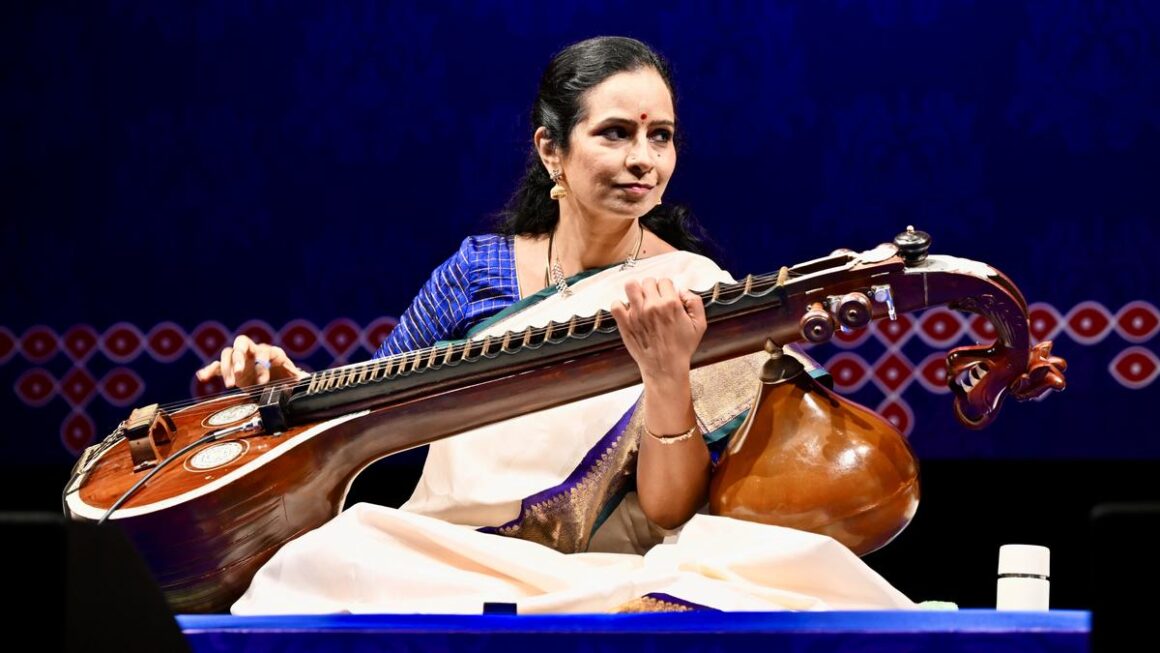
Jayanthi Kumaresh presented a well-structured Lathangi alapana.
| Photo Credit: RAGHUNATHAN SR
Instrumentalists, particularly those who play the veena, usually have a hard time retaining the audience’s attention. Since most rasikas strongly correlate Carnatic music to sahitya, they prefer listening to familiar kritis. This makes it difficult for instrumentalists as they have to repeat some well-known songs or ragas.
Vidushi Jayanthi Kumaresh is someone who accords maximum priority to audience engagement. There was never a dull moment at her recital for The Music Academy.
Starting off pleasantly with Muthuswami Dikshitar’s ‘Parvati Kumaram’ in Nattakurinji, she played kalpanaswaras that had flowing raga-alapana-like elements and showed an influence of tanam. She next explored Lathangi with a neat, structured alapana taking up the composition ‘Pirava varam thaarum’ by Papanasam Sivan. Handling high-speed swaras is a skill she has nurtured over the years.
Jayanthi Kumaresh accompanied by K.U. Jayachandra Rao on the mridangam and Trichy S. Krishnaswamy on the ghatam.
| Photo Credit:
RAGHUNATHAN SR
Prefacing every piece with a short introduction either about the raga or the composition, Jayanthi made sure the audience grasped what she conveyed musically. Her alapana of Mukhari for ‘Entani ne varnintunu’ mirrored the gayaki approach and reflected the mood and characteristics of the raga from the very first phrase. Her next raga for elaboration was Saveri, where her alapana stood out for some long single-meetu phrases and judicious coverage of all three octaves. Jayanthi rendered kalpanaswaras in both speeds at ‘Dhara dharavi neela’. Her melkala swaras never lost the essence of the raga, showcasing its salient features appropriately.
Kantamani, the 61st melakarta raga, is rarely sung in concerts. It is a prati madhyama raga and stands out with shuddha daivatam (D1) and shuddha nishadham (N1) in the uttarangam. After a detailed exposition of the raga in her alapana, Jayanthi played a delightful tanam that resonated well with the audience as she employed a range of left-hand techniques. Her pallavi ‘Jaya jaya shankara hara hara shankara kanchi kamakoti peetha’ was set in Tisra jathi Jhampa tala. A set of neat kalpanaswaras with systematic kanakku endings resulted in Jayanthi’s signature ascent to the uppermost octave in the final swara, cementing her chemistry with rasikas who immediately applauded at the final meetu.
Jayanthi was accompanied by K.U. Jayachandra Rao on the mridangam and Trichy S. Krishnaswamy on the ghatam. The percussionists provided good support throughout the kutcheri, playing quite suitably for the veena.
Some of the other pieces included a thillana in Mishra Shivaranjani composed by Lalgudi Jayaraman and ‘Kamakshi loka sakshi’ in Madhyamavati by Syama Sastri.
Published – January 13, 2025 06:12 pm IST


Leave a Reply